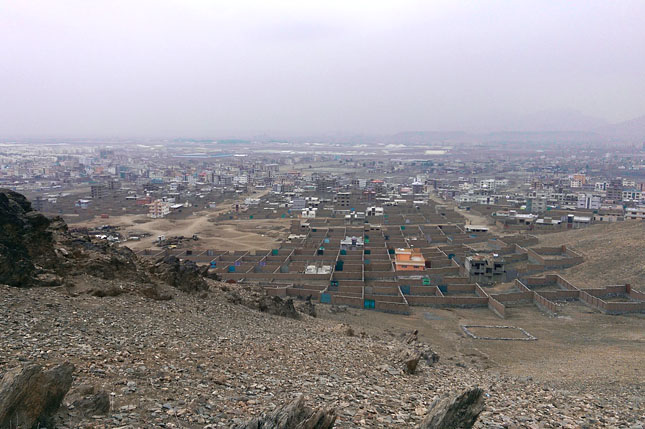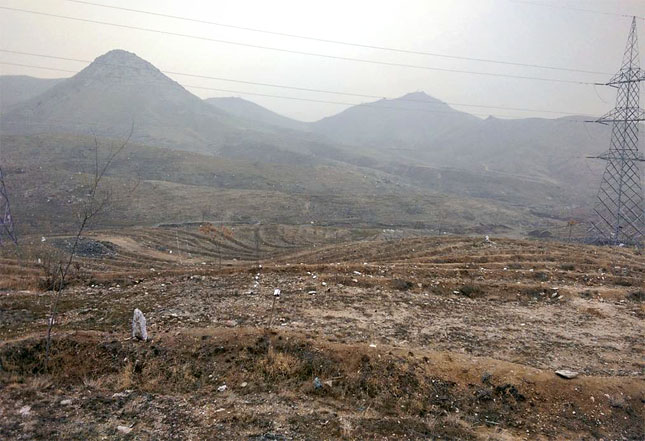-
Kabul Greenbelt Project Aims to Restore Some Luster to War-Ravaged Capital – and Resilience Too
March 15, 2016 By Elizabeth B. Hessami
It’s hard to imagine today, but Kabul was once ringed with grassy areas and shrubs, a few trees in areas too. Some of my husband’s favorite recollections of early 1970s Afghanistan are of simple family picnics in picturesque parks. Hours of lounging, grilling kebab, preparing rice, and conversing were a respite from the oppressive heat of the capital. Sometimes a picnic would become an all-night, extended family gathering. The Gardens of Paghman were a favorite destination with rows of pine trees, roses, and cool fountains. Pre-war family photos reveal neatly trimmed trees, bushes, and ample grassy areas for impromptu games. The family picnic is still popular among the Afghan diaspora. In the United States, Afghan community events are often held in parks, and involve large, multi-family picnics.
The parks and green space around Kabul had considerable cultural and social importance and provided vital environmental value. Since war first broke out almost four decades ago, however, these areas have been almost completely degraded or destroyed. This year, a new initiative promises to bring some of it back.
The Deforestation of Afghanistan
Afghanistan once had several verdant forests, including evergreen, oak, pistachio, and pine woods. According to the United Nations Environment Program (UNEP), evergreens alone covered as much as five percent of the country before the conflict period, and there were millions of hectares of oak and pine. Overall, UNEP estimates Afghanistan has lost 50 percent of its forests over the past three decades.
Afghanistan has lost half its forest cover in the last 30 yearsIn the northern provinces of Badghis and Takhar, there were fertile pistachio forests which brought in significant revenue to local villagers. There is some hope of bringing these back due to the pistachio’s hardy nature, but today, most of the other forests have been destroyed due directly to armed conflict, the financing of armed conflict, or through the sale and usage of timber for heating.
The deforestation of Afghanistan began with the Soviet occupation in 1979. Trees farther away from Kabul were often the first to be destroyed as they provided cover for resistance forces such as the Mujahideen. Extended combat sparked fires, and there have been several reports of the Soviet Union using herbicides to defoliate large areas during the occupation as well, as the United States did in Vietnam. Emergency housing for returning refugees, particularly after the fall of the Taliban in the early 2000s, further contributed to the decline of green space around Kabul in particular.
A simultaneous driver of deforestation is escalating demand for firewood. Since 1980, the population of Afghanistan has increased from 13.2 million people to more than 32.5 million. Wood is the primary heat source for most Afghans, who rely on bukharis, small wood-burning stoves, for cooking and heating. Just one house used by foreign journalists in Kabul burned several tons of firewood during the cold months of 2013. Illegal timber smuggling has become a lucrative industry to meet demand.

Greening for the Future
This degradation, along with instability, lack of institutional capacity, and the country’s geography, make Afghanistan one of the most vulnerable nations in the world to the effects of climate change. It is projected that the annual mean temperature will continue to rise while droughts, landslides, and periods of intense flooding increase in frequency. These effects may further escalate the chances of instability and armed conflict as resources become more scarce.
Restoring green space – trees, grasses, foliage – can be an effective method of reducing vulnerability to flooding and erosion of topsoil, particularly on sloping ground. Capturing more water through absorption before it runs off also increases the recharge rate of groundwater.
The project aims to create more than 10,000 hectares of green space over 10 yearsOne of the first major concerted efforts by the Afghan Government – not an NGO or foreign government – to address these problems is starting in Kabul.
On January 30, the Ministry of Agriculture, Irrigation, and Livestock of the Islamic Republic of Afghanistan (MAIL) announced the start of the Kabul Greenbelt Project. Over 10 years, the project aims to create more than 10,000 hectares of green space around Kabul, including 4,000 hectares of forested area. By the end of 2016, 500 hectares are planned for greening in the Asmai and Shi Darwaza mountains, Qargha, and near the Kabul airport with saplings and seeds chosen for their drought-resistant natures.
“The overall goal of the project is to ensure our environmental sustainability and provide a green future for the citizens of Kabul,” said Minister of MAIL Assadullah Zamir in his remarks.
The project also hopes to bring employment opportunities. MAIL estimates the project could produce up to 150,000 man-day work hours in 2016 for gardeners, urban planners, drivers, and landscapers.
Corruption and Conflict
While the project is being initiated by MAIL and spearheaded by the General Directorate of Natural Resources Management, the involvement of several ministries and the community at large will be necessary to make it a success.
Implementing any major project in Afghanistan is a challenge. There is still significant disruption due to armed conflict. Just last month, a joint Afghan Army and U.S. military operation was required to clear Taliban fighters north of the capital and restore electricity to the capital.
The project is also relatively expensive, with an estimated cost of about $3 million for the first year and total projected cost to reach $40 million. And corruption is a major issue. Afghanistan ranks as one of the world’s least transparent nations on the 2014 Corruption Perceptions Index, coming in at number 172 out of 174. The number of agencies involved in the project may increase the odds of money ending up where it is not supposed to.
Educating the public about the need to preserve and care for green space is therefore critical to the success of the project. The ministry hopes to convince local residents about the importance of the environment to their health and wellbeing. More demand for transparency by local communities in projects such as this one are necessary to reduce graft, which may come as the community sees the benefits of a healthier environment.
The hope is that the Kabul Greenbelt Project is the beginning of a more sustainable, peaceful future for Afghanistan. Climate change and continuing development are strong incentives to improve natural resource management sooner rather than later. Time will tell if the Greenbelt Project’s effort to restore an Afghanistan of the past lives up to the realities of today.
Elizabeth B. Hessami, J.D., LL.M. (Environmental Law), is a visiting attorney for the Environmental Law Institute in Washington D.C. researching conflict/post-conflict environmental issues in Afghanistan.
Sources: ABC, Environment News Service, IndiaToday, Ministry of Agriculture, Irrigation, and Livestock (Afghanistan), NPR, New Hampshire Public Radio, The New York Times, Radio Free Europe/Radio Liberty, Transparency International, U.S. Agency for International Development, U.S. Department of Agriculture, United Nations Environment Program, United Nations High Commissioner for Refugees, United Nations Population Division.
Photo Credit: The Qasaba region, north of Kabul, and Qargha region, west of the city, used with permission courtesy of Sayed Khalid/Ministry of Agriculture, Irrigation, and Livestock.
 A Publication of the Stimson Center.
A Publication of the Stimson Center.







